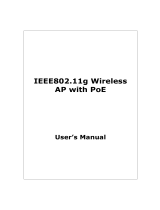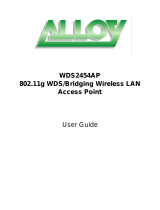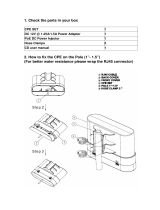Page is loading ...


Table of Contents
Chapter 1. System Overview.......................................................................................................................... 1
1.1 Introduction of TEW-455APBO……………………………………………………………………………………………………….1
1.2 System Concept………………………………………………………………………………………………………………………………2
1.3 Applications in Wireless Network……………………………………………………………………………………………………3
1.4 Product Benefit……………………………………………………………………………………………………………………………….7
1.5 Specification……………………………………………………………………………………………………………………………………8
1.6 Wireless Performance Considerations……………………………………………………………………………………….11
Chapter 2. Basic Installation…………………………………………………………………………………………………………………….12
2.1 Hardware Installation……………………………………………………………………………………………………………………12
2.1.1 Package Contents…………………………………………………………………………………………………………………..12
2.1.2 Panel Function Descriptions…………………………………………………………………………………………………..12
2.2 Web Management Interface Instructions………………………………………………………………………………………13
Chapter 3. AP Mode Configuration………………………………………………………………………………………………………….16
3.1 External Network Connection……………………………………………………………………………………………………….16
3.1.1 Network Requirement…………………………………………………………………………………………………………..16
3.1.2 Configure LAN IP……………………………………………………………………………………………………………………17
3.2 Wireless LAN Network Creation……………………………………………………………………………………………………19
3.2.1 Wireless General Setup………………………………………………………………………………………………………….19
3.2.2 Wireless Advanced Setup……………………………………………………………………………………………………….21
3.2.3 Create Virtual AP (VAP)…………………………………………………………………………………………………………..25
3.2.3.1 Virtual AP Overview ………………………………………………………………………………………………………..25
3.2.3.2 Virtual AP Setup………………………………………………………………………………………………………………27
3.2.4 MAC Filter Setup…………………………………………………………………………………………………………………….34
3.3 Wireless Network Expansion………………………………………………………………………………………………………….35
3.4 System Management…………………………………………………………………………………………………………………….38
3.4.1 Configure Management…………………………………………………………………………………………………………38
3.4.2 Configure System Time………………………………………………………………………………………………………….41
3.4.3 Configure UPnP………………………………………………………………………………………………………………………42
3.4.4 Configure SNMP Setup……………………………………………………………………………………………………………43
3.4.5 Backup / Restore and Reset to Factory……………………………………………………………………………………45
3.4.6 Firmware Upgrade………………………………………………………………………………………………………………….46
3.4.7 Network Utility………………………………………………………………………………………………………………………..47
3.4.8 Reboot…………………………………………………………………………………………………………………………………….48
3.5 System Status………………………………………………………………………………………………………………………………….49
3.5.1 System Overview…………………………………………………………………………………………………………………….49
3.5.2 Associated Clients Status…………………………………………………………………………………………………………51
3.5.3 WDS Link Status………………………………………………………………………………………………………………………52
3.5.4 Extra Information……………………………………………………………………………………………………………………53
3.5.5 Event Log………………………………………………………………………………………………………………………………..55
Chapter 4. WDS Mode Configuration………………………………………………………………………………………………………..56
4.1 External Network Connection…………………………………………………………………………………………………………56
4.1.1 Network Requirement…………………………………………………………………………………………………………….56
4.1.2 WDS Setup………………………………………………………………………………………………………………………………57
4.2 System Status………………………………………………………………………………………………………………………………….59
4.2.1 System Overview…………………………………………………………………………………………………………………….59
4.2.2 WDS Link Status………………………………………………………………………………………………………………………61
Chapter 5. CPE Mode Configuration………………………………………………………………………………………………………….62
5.1 External Network Connection…………………………………………………………………………………………………………62
5.1.1 Network Requirement…………………………………………………………………………………………………………….62
5.1.2 Configure WAN Setup……………………………………………………………………………………………………………..63
5.1.3 Configure DDNS Setup…………………………………………………………………………………………………………….66

5.1.4 Site Survey……………………………………………………………………………………………………………………………..67
5.2 Access Control List…………………………………………………………………………………………………………………………68
5.2.1 IP Filter Setup…………………………………………………………………………………………………………………………68
5.2.2 MAC Filter Setup…………………………………………………………………………………………………………………….70
5.3 Resource Sharing……………………………………………………………………………………………………………………………71
5.3.1 DMZ……………………………………………………………………………………………………………………………………….71
5.3.2 Virtual Server (Port Forwarding)…………………………………………………………………………………………….72
5.4 System Status…………………………………………………………………………………………………………………………………74
5.4.1 System Overview……………………………………………………………………………………………………………………74
5.4.2 DHCP Clients………………………………………………………………………………………………………………………….78
6. Command Line Interface(CLI)………………………………………………………………………………………………………………79
6.1 Accessing the CLI with Telnet…………………………………………………………………………………………………………79
6.2 Accessing the CLI with SSH Utility…………………………………………………………………………………………………..80
6.3 Using the CLI………………………………………………………………………………………………………………………………….81
Appendix A. WEB GUI Valid Characters………………………………………………………………………………………………….85
Appendix B. Network manager Privileges………………………………………………………………………………………………89
Appendix C. Enabling UPnP in Windows XP……………………………………………………………………………………………90
Limited Warranty…………………………………………………………………………………………………………………………………….92

User Manual
TEW-455APBO High Power Wireless Outdoor PoE Access Point
1
Chapter 1. System Overview
1.1 Introduction of TEW-455APBO
The 802.11 b/g compliant TEW-455APDO is an outdoor wireless device that can be used for five different
purposes in three different modes. In the AP mode, it can be deployed either as traditional fixed wireless
Access Point (AP), or combination of AP and WDS(AP+WDS). In the WDS mode, it’s only used to expand or
bridge Ethernet networks and deployed as a main base, relay based or remote base station. In the CPE mode,
it connects to Wireless Internet Service Provider’s (WISP) outdoor network via wireless WAN gateway to
access to Internet.
The die-cast sealed TEW-455APDO is compact in size and compliant with IP66/IP67 weatherproof standard. It
comes with a mounting kit to mount on pole or wall. It is suitable for both indoor and outdoor usage with its
adjustable output power.
1. Access Point : It can be deployed as a traditional fixed wireless Access Point
2. Repeater: To expand wireless service by repeating prior AP
3. WDS : It can be used to expand Ethernet network via wireless WDS Link
4. AP+WDS: Not only to extend Ethernet network, but also provide wireless access to the expanded
network
5. CPE (Customer Premises Equipment): It is a wireless gateway with NAT and DHCP Server functions to
connects to Wireless Internet Service Provider's (WISP)

User Manual
TEW-455APBO High Power Wireless Outdoor PoE Access Point
2
1.2 System Concept
The TEW-455APDO is not only designed and used as traditional outdoor AP, but also with rich features tailored
for WISP applications. The two-level management capability and access control ease WISP and owners to
maintain and manage wireless network in a more controllable fashion. Main applications are listed as follows
with illustration:
Wireless CPE for Multi Dwelling Unit/Multi Tenant Unit (MDU/MTU) complexes including apartments,
dormitories, and office complexes.
Outdoor Access Point for school campuses, enterprise campuses, or manufacture plants.
Indoor Access Point for hotels, factories, or warehouses where industrial grade devices are preferred.
Public hotspot operation for café, parks, convention centers, shopping malls, or airports.
Wireless coverage for indoor and outdoor grounds in private resorts, home yards, or golf course
communities.

User Manual
TEW-455APBO High Power Wireless Outdoor PoE Access Point
3
1.3 Applications in Wireless Network
TEW455APBO is a multiple mode system which can be configured either as a wireless gateway or an access
point as desired. It also can be used WDS link for Ethernet network expansion. This section depicts different
applications on AP Mode, WDS Mode, and CPE Mode.
Configuration in AP Mode (including Access Point + WDS)
An access point can be either a main, relay or remote base station. A main base station is typically
connected to a wired network via the Ethernet port. A relay base station relays data between main base
stations and relay stations or remote base stations with clients. A remote base station is the end point to
accept connections from wireless clients and pass data upwards to a network wirelessly.
Example 1 : Access Point without WDS
It can be deployed as a tradition fixed wireless Access Point
Example 2 : Access Point with WDS
It can be deployed as a tradition fixed wireless Access Point and provides WDS link to expand
network

User Manual
TEW-455APBO High Power Wireless Outdoor PoE Access Point
4
Configuration in WDS Mode (Pure WDS)
An access point can be either a main, relay or remote base station. A main base station is typically
connected to a wired network via the Ethernet port. A relay base station relays data between main base
stations and relay stations or remote base stations with clients. A remote base station is the end point to
accept connections from wireless clients and pass data upwards to a network wirelessly. In this mode, it
can support single or multiple WDS links and no wireless clients can associate with it though.
Example 1 : Point-to-Point

User Manual
TEW-455APBO High Power Wireless Outdoor PoE Access Point
5
Example 2 : Point-to-Multi-Point
Example 3 : Multi-Point Repeating bridge

User Manual
TEW-455APBO High Power Wireless Outdoor PoE Access Point
6
Configuration in CPE Mode
It can be used as an Outdoor Customer Premises Equipment (CPE) to receive wireless signal over last mile
application, helping WISPs deliver wireless broadband Internet service to residents and business
customers. In the CPE mode, TEW-455APBO is a gateway enabled with NAT and DHCP Server functions.
The wired clients connected to TEW-455APBO are in different subnet from those connected to Main Base
Station, and, in CPE mode, it does not accept wireless association from wireless clients.

User Manual
TEW-455APBO High Power Wireless Outdoor PoE Access Point
7
1.4 Product Benefit
High Adjustable Output Power up to 27dBm (FCC version)/6dBm (EU version)
Topology : Point to Point ; Point to Multi Point
Operation Modes :
Access Point Mode : Pure Access Point Function and Access Point /Bridge(WDS) Function
WDS Mode
CPE Mode (Router Client )
Security with WEP, WPA/WPA2-PSK, and WPA/WPA2-RADIUS
Over load current protection
Integrated Power over Ethernet (PoE)
8 Multiple B-SSID capability
Business-class security and central management
IP66/IP67 Weather-Proof Housing
VLAN tag over WDS
Client Isolation through Layer 2 VLAN technology
TEW-455APBO is the point of connection to Wireless Outdoor Network for service provider deploying last mile
services to business or residential broadband subscribers.. Network administrators can create multiple
subscriber service tier using per-subscriber rate limiting features, and manage centrally. TEW-455APBO
outdoor bridge utilizes adjustable output Tx Power to connect to the Wi-Fi mesh or WDS infrastructure and
provides the subscriber with an Ethernet connection for a local access.
TEW-455APBO supports three operational modes, the AP mode, the WDS mode and the CPE mode,
respectively with built-in remote management features.

User Manual
TEW-455APBO High Power Wireless Outdoor PoE Access Point
8
1.5 Specification
Wireless Architecture Mode
AP Mode
Pure AP Mode
It can be deployed as a tradition fixed wireless Access Point
It allow wireless clients or Stations(STA) to access
AP/WDS Mode
This enables the wireless interconnection of Access Point in an IEEE802.11 network .and
accept wireless clients at the same time
WDS Mode
This enables the wireless interconnection of Access Point in an IEEE802.11 network.
It allows a wireless network to be expanded using multiple access point without the need for a
wired backbone to link them.
It can’t allow wireless clients or Stations (STA) to associate.
CPE Mode
Wi-Fi connection as WAN , in CPE mode , the device run as DHCP server to assign IP address to
clients out of a private IP address pool behind a NAT
Networking
Support Static IP, Dynamic IP(DHCP Client) and PPPoE on Wi-Fi WAN Connection
Support PPTP/L2TP/IP Sec Pass Through
PPPoE Reconnect – Always On , On demand, Manual
MAC Cloning
DHCP Server
802.3 Bridging
Masquerading (NAT)
Proxy DNS
Dynamic DNS
NTP Client
Virtual DMZ

User Manual
TEW-455APBO High Power Wireless Outdoor PoE Access Point
9
Virtual Server (IP / Port Forwarding)
Support MAC Filter (max 20 entries)
Support IP Filter (max 20 entries)
Bandwidth traffic Shaping
Wireless Feature
Transmission power control : 9 Levels (max 27dBm for FCC, 6dBm for CE)
Channel selection : Manual or Auto
No of associated clients per AP : 32
Setting for max no associated clients : Yes
No. of ESSID (Virtual AP) : 8
No. of Max. WDS setting : 8
Preamble setting : Short/ Long
Setting for 802.11b/g mix, 802.11b only or 802.11g only
Setting for transmission speed
Dynamic Wireless re-transmission
IEEE802.11f IAPP (Inter Access Point Protocol), hand over users to another AP
IEEE 802.11i Preauth (PMKSA Cache )
IEEE 802.11h -Transmission Power Control
IEEE 802.11d -Multi country roaming
Authentication/ Encryption (Wireless Security)
Layer 2 User Isolation
Blocks client to client discovery within a specified VLAN
WEP 64/ 128/ 152 Bits
EAP-TLS + Dynamic WEP
EAP-TTLS + Dynamic WEP
PEAP/ MS-PEAP + Dynamic WEP
WPA (PSK +TKIP)
WPA (802.1x certification + TKIP)

User Manual
TEW-455APBO High Power Wireless Outdoor PoE Access Point
10
802.11i WPA2 (PSK + CCMP/ AES)
802.11i WPA2 (802.1x certification + CCMP/ AES)
Setting for TKIP/ CCMP/ AES key’s refreshing period
Hidden ESSID support
Setting for “ Deny ANY “ connection request
MAC Address filtering (MAC ACL)
No. of registered RADIUS servers : 2
VLAN assignment on BSSID
Support VLAN tag over WDS
Quality of Service
DiffServ/ TOS
IEEE802.1p/ COS
IEEE 802.1Q Tag VLAN priority control
IEEE802.11e WMM
System Administration
Intuitive Web Management Interface
Password Protected Access
Firmware upgrade via Web
Reset to Factory Defaults
Profiles Configuration Backup and Restore
Remote Link Test
Full Statistics and Status Reporting
SNMP Traps to a list of IP Address
NTP Time Synchronization
Even Log
Support SNMP v1,v2c, v3
Support MIB II
CLI access via Telnet and SSH

User Manual
TEW-455APBO High Power Wireless Outdoor PoE Access Point
11
Administrative Access : HTTP/ HTTPS
UPnP (Universal Plug and Play)
1.6 Wireless Performance Considerations
There are a number of factors that can impact the range of wireless devices.
1. Adjust your wireless devices so that the signal is traveling in a straight path, rather than at an angle. The
more material the signal has to pass through the more signal you will lose.
2. Keep the number of obstructions to a minimum. Each obstruction can reduce the range of a wireless
device. Position the wireless devices in a manner that will minimize the amount of obstructions between
them.
3. Building materials can have a large impact on your wireless signal. In an indoor environment, try to
position the wireless devices so that the signal passes through less dense material such as dry wall. Dense
materials like metal, solid wood, glass or even furniture may block or degrade the signal.
4. Antenna orientation can also have a large impact on your wireless signal. Use the wireless adapter’s site
survey tool to determine the best antenna orientation for your wireless devices.
5. Interference from devices that produce RF (radio frequency) noise can also impact your signal. Position
your wireless devices away from anything that generates RF noise, such as microwaves, radios and baby
monitors.
6. Any device operating on the 2.4GHz frequency will cause interference. Devices such as 2.4GHz cordless
phones or other wireless remotes operating on the 2.4GHz frequency can potentially drop the wireless
signal. Although the phone may not be in use, the base can still transmit wireless signal. Move the
phone’s base station as far away as possible from your wireless devices.
If you are still experiencing low or no signal consider repositioning the wireless devices or installing additional
access points. The use of higher gain antennas may also provide the necessary coverage depending on the
environment.

User Manual
TEW-455APBO High Power Wireless Outdoor PoE Access Point
12
Chapter 2. Basic Installation
2.1 Hardware Installation
2.1.1 Package Contents
TEW-455APBO x 1
Multi-Language Quick Installation Guide x 1
CD-ROM (User’s Guide) x 1
Power Injector & Cord x 1
Mounting Kit x 1
It is highly recommended to use all the supplies in the package instead of substituting any components by other suppliers
to guarantee best performance.
2.1.2 Panel Function Descriptions
TEW-455APBO
1. Reboot:
Press and hold the Reset button for 2 seconds and release to restart system. The LED except Power
indicator will be off before restarting.
Press and hold the Reset button for more than 10 seconds to reset the system to default
configurations.
2. Power: Green LED ON indicates power on, and OFF indicates power off.
3. WLAN: Yellow LED FLASH indicates Wireless Transmit.
4. Ethernet Red LED ON indicates connection, OFF indicates no connection
5. PoE: For connecting to PSE
6. EXT: For connection of optional N-Type antenna (example: TRENDnet TEW-AO19D)

User Manual
TEW-455APBO High Power Wireless Outdoor PoE Access Point
13
2.2 Web Management Interface Instructions
TEW-455APBO supports web-based configuration. Upon the completion of hardware installation, TEW-
455APBO can be configured through a PC/NB by using its web browser such as Internet Explorer version 6.0 or
higher.
Default IP Address : 192.168.10.100
Default Subnet Mask : 255.255.255.0
Default User Name and Password:
The default user name and password for both root manager account and admin manager account are as
follows:
Mode
CPE Mode
AP Mode
WDS Mode
Management Account
Admin Account
Status Account
Admin Account
Admin Account
User Name
root
admin
root
root
Password
root
admin
root
root
Step
IP Segment Set-up for Administrator's PC/NB
Set the IP segment of the administrator's computer to be in the same range as TEW-455APBO for
accessing the system. Do not duplicate the IP Address used here with IP Address of TEW-455APBO or any
other device within the network
Example of Segment:
The valid range is 1 ~ 254 and 192.168.10.100 shall be avoided because it is already assigned to TEW-
455APBO and 192.168.10.10 is used in the example below.
IP Address : 192.168.10.10
IP Netmask : 255.255.255.0

User Manual
TEW-455APBO High Power Wireless Outdoor PoE Access Point
14
Launch Web Browser
Launch a web browser to access the web management interface of system by entering the default IP
Address, http://192.168.10.100, in the URL field, and then press Enter.
System Login
The network manager Login Page then appears.
Enter “root” as User name and “root” as Password, and then click OK to login to the system; the root
manager account is used as an example here.

User Manual
TEW-455APBO High Power Wireless Outdoor PoE Access Point
15
Login Success
System Overview page will appear after successful login.

User Manual
TEW-455APBO High Power Wireless Outdoor PoE Access Point
16
Chapter 3. AP Mode Configuration
When AP mode is chosen, the system can be configured as an Access Point. This section provides detailed
explanation for users to configure in the AP mode with help of illustrations. In the AP mode, functions listed in
the table below are also available from the Web-based GUI interface.
Option
System
Wireless
Administrator
Status
Functions
Operating Mode
General Settings
Management
System Overview
LAN
Advanced Settings
Profiles Settings
Clients
Time Server
Virtual AP
Firmware Upgrade
WDS Status
SNMP
WDS Setup
Network Utility
Extra Info
UPNP
Reboot
Event Log
Table 3-1: AP Mode Functions
3.1 External Network Connection
3.1.1 Network Requirement
Normally, TEW-455APBO connects to a wired LAN and provides a wireless connection point to associate with
wireless client as shown in Figure 3-1. Then, Wireless clients could access to LAN or Internet by associating
themselves with TEW-455APBO set in AP mode.
Figure 3-1 Access Point on a Wired LAN Configuration

User Manual
TEW-455APBO High Power Wireless Outdoor PoE Access Point
17
3.1.2 Configure LAN IP
Here are the instructions to setup the local IP Address and Netmask.
Please click on System LAN and follow the below setting.
Mode: Check either “Static IP” or “Dynamic IP” button as desired to set up the system IP of LAN port.
Static IP: The administrator can manually setup the LAN IP address when static IP is preferred.
IP Address: The IP address of the LAN port; default IP address is 192.168.10.100
IP Netmask: The Subnet mask of the LAN port; default Netmask is 255.255.255.0
IP Gateway: The default gateway of the LAN port; default Gateway is 192.168.10.1
Dynamic IP: This configuration type is applicable when the TEW-455APBO is connected to a network
with presence of a DHCP server. All related IP information will be provided by the DHCP server
automatically.
Hostname : The Hostname of the LAN port
/



